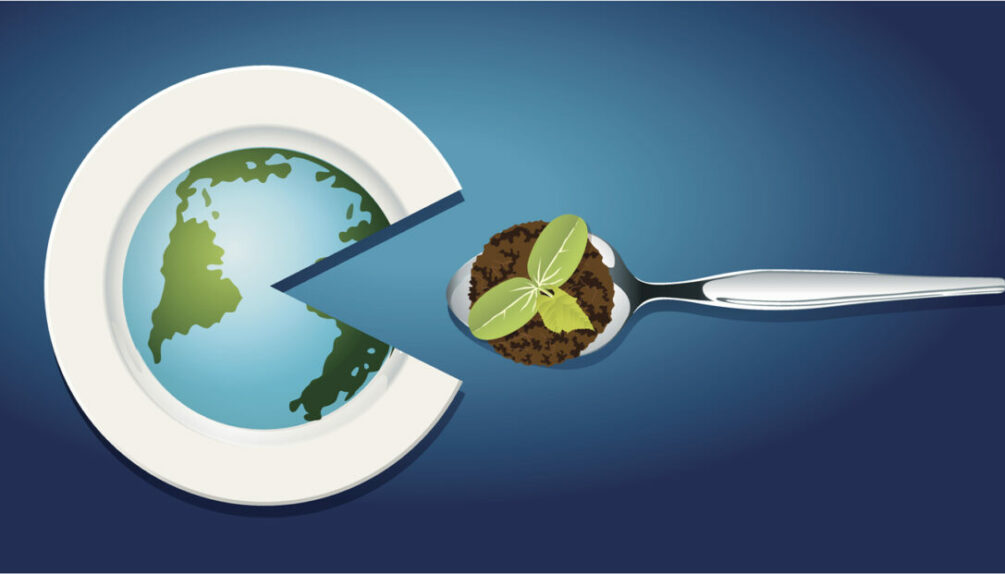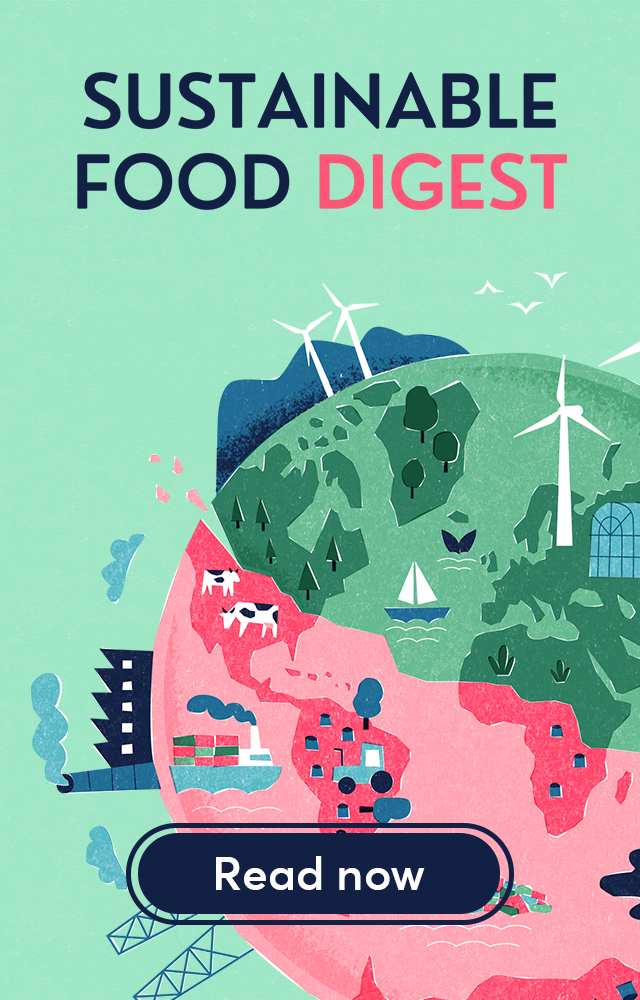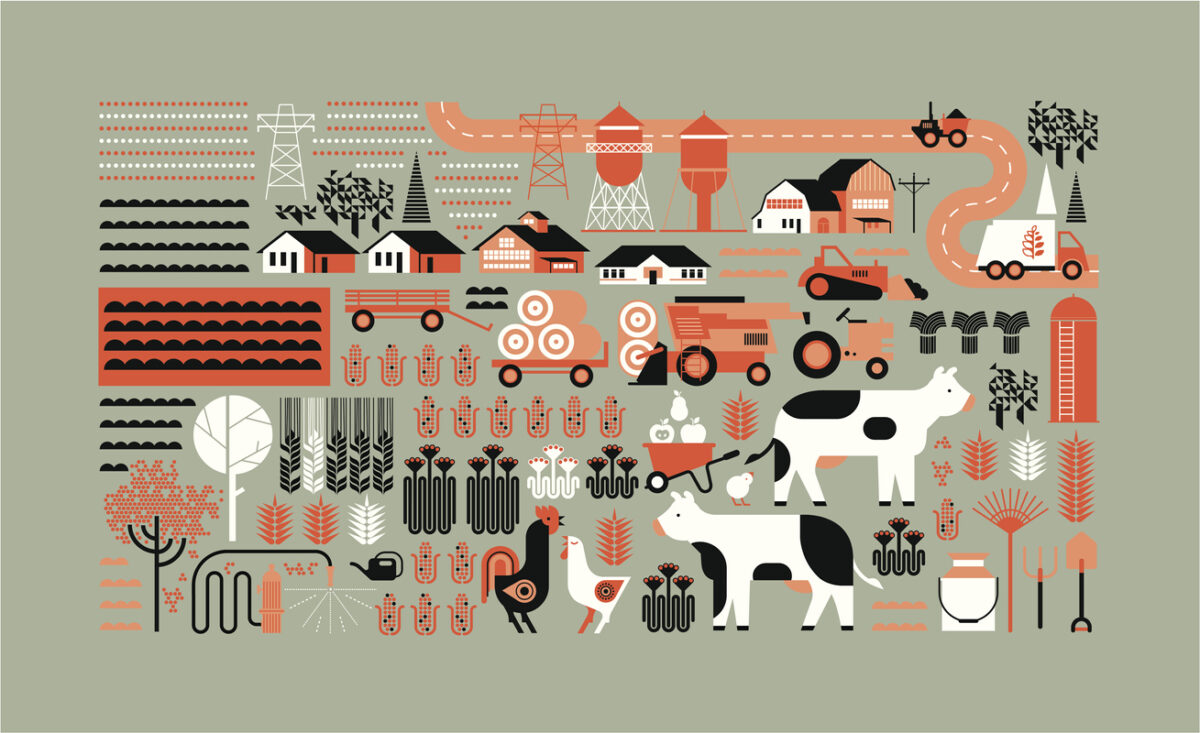Top 10 food sustainability trends for 2023

From factories to farming, and indeed factory farming, producing enough for us all to eat and drink has a huge impact on this planet. Food production accounts for more than a quarter (26%) of global greenhouse gas emissions and is full of complex and convoluted supply chains. But huge progress is now being made from plot to plate. While some businesses are repurposing fruit peelings, others are greening their financial strategies. Gradually, more food companies are beginning to shift towards a more circular, less wasteful model to help transform the system’s environmental impacts. We speak to industry experts to discover the 10 most promising food and drink sustainability trends of 2023.
Upcycled foods
More brands are proudly shouting about using ingredients previously classed as waste. Toast Ale ferments surplus bread to make beer, Regrained makes flour from the protein, fibre and micronutrients discarded after grain is used in beer brewing, and Dirt Kitchen creates plant-based snack bars from surplus courgettes, carrots and green beans. US-based Renewal Mill makes flour using by-products from plant-based milks, Rubies in the Rubble transforms waste fruit and wonky veg into condiments, while Seven Bro7hers use discarded Coco Pops to make this chocolatey stout. Veg box scheme Oddbox fights food waste by marketing produce rejected by mainstream supermarkets for being too ugly, small or funny-shaped. This conscious upcycling is happening behind the scenes too. More own label producers are starting to redirect food waste within supply chains. For example, Co-op identified 57 tonnes of waste resulting from the production of its Honest Value Cottage Pie ready meal. Skin-on potato processing is now being trialled, and potatoes may be diced into smaller pieces in the future while the stock ordering system could be adapted to minimise waste of unsold products.
Lower-impact cooking
With the pinch of the cost of living crisis, energy-efficient gadgets, from air fryers and multicookers to induction hobs and pressure cookers are here to stay. “A side effect of the fuel crisis is long-term sustainable cooking, I hope,” says Catherine Phipps, author of the Modern Pressure Cooking: The Comprehensive Guide to Stovetop and Electric Cookers, with Over 200 Recipes. She has noticed that low-impact cookery is starting to influence kitchen design too, with induction hobs and worktop space for air fryers taking priority over ovens – which up till now have taken centre stage. As well as customers actively seeking out energy-saving products, as Mintel’s latest food and drink trend report highlights, brands will start including more microwaveable claims and air-fryer instructions. Managing Director of food sustainability consultancy Achieve Goal 12 Andy Young predicts more brands will also share recipes, food waste hacks, hints and tips that empower consumers to cook more efficiently and reduce their household bills. “It’s not just about unconscious consumption – it’s also about how you use store cupboards, freezers, batch cooking to help mitigate some of those cost price increases,” explains Young, who flags up Hellmann’s recent Cook Clever Waste Less campaign.
Sustainable crops
The Ellen MacArthur Foundation (EMF) predicts a rise in diversity of ingredients in the meals we eat. “This is such an overlooked area,” says Rebecca Hesketh, Programme Manager for the Food Initiative at the Foundation. “Nature thrives on diversity, you don’t see monocultures in nature. Diversity brings so much value to our food system, in terms of resilience particularly, and also in creating those positive interactions [between animals and plants] that give the opportunity for nature to thrive.” Hesketh foresees more manufacturers incorporating new ingredients into their recipes, for example using pea protein alongside wheat to produce a lower-impact pasta: “Peas are a legume, they can synthesise nitrogen and enrich the soil so this is a fantastic example of a lower impact food having a positive impact.” Crop diversity underpins food security, and despite increasing climate impacts, just four grains dominate globally: wheat, maize, soya and rice account for almost half the world’s agricultural land. Award-winning company Hodmedod’s challenges this norm by selling less well-known pulses such as fava beans and grains, including hemp and quinoa, on British farms.
Reniera O’Donnell, Food Initiative Lead, Ellen MacArthur Foundation (UK), will be speaking at Food Matters Live‘s Sustainable Food Forum on 19-20 September on the panel Can (re)formulation save us?
Farming for nature
“Regenerative production holds so much potential,” says Hesketh who expects to see this agricultural practice become more mainstream. “Quite often in the business world, we talk about reducing harm, but from our position that’s no longer good enough, it’s about being positively good.” She explains this nature-positive farming philosophy must always be context-specific – there’s no one-size fits all. But as ‘regenerative’ becomes more mainstream than buzzword, Andy Young flags up a word of caution. The term has no legal definition, and “there’ll be a huge plethora of different standards” he warns, so it’s potentially open to misinterpretation or misuse. Ribena is trialling 60 acres of regenerative blackcurrant production and Unilever has published its regenerative agriculture principles. Zac Goodall, Head of Sustainability at organic veg box company Riverford, says that altering just one component of a food system is not truly regenerative – a whole systems approach is required. At a farm level, that covers everything from soil health and crop biodiversity to making space for nature and reducing chemical inputs such as pesticides while streamlining carbon footprints and eliminating waste. Regenerative Organic Alliance has piloted a new certification scheme that prioritises soil health, animal welfare and social fairness, with 134 farms signed up so far.
Ecolabelling
Just as traffic light scores highlight nutritional ratings of foods to help consumers check everything from salt content to calories, front-of-pack environmental food labelling is evolving. Young highlights that the Institute of Grocery Distribution (IGD) is working on draft framework recommendations for the UK food industry: “IGD is working on a consistent labelling scheme that goes beyond solely carbon. A broader set of metrics will include measures of water consumption and biodiversity.” A scheme called Eco-Score is being trialled by big European retailers like Lidl, while NGO Foundation Earth is running two pilots for environmental impact scoring systems in collaboration with brands such as Nestlé, Sainsbury’s and Morrisons. As Food Matters Live recently reported, world experts are also being invited to partner with Foundation Earth’s scientific committee and join the likes of Professor Chris Elliott and Dutch sustainable agriculture expert Koen Boone to lead the coordination between other leading ecolabelling initiatives across Europe.
Greener food finance
Perhaps this is one trend that will remain invisible to shoppers, but it could become one of the most impactful. Food and drink businesses will have to ensure their transactions are consistently sustainable as they prioritise ESG (environmental, social, and corporate governance). As Young explains, the new Taskforce on Climate-related Financial Disclosures (TCFD), created by the Financial Stability Board in 2017, outlines how businesses have to consider climate impacts in terms of their strategic and financial planning. “As that becomes more mature, you’ll start to see more finance directors embedding carbon and climate into their decision making. So it won’t just be the preserve of the likes of me,” he says. “Embedding sustainability within financial decisions needs to happen quickly…it’s building all the time and this could be a big game changer in terms of how businesses plan and build in a resilient way.”
Reducing meat and dairy
Although the plant-based trend has been popular for some time, supermarkets still have big net zero commitments. That could be achieved, in part, by reducing meat and dairy consumption, Young says, as outlined by WWF’s Livewell diet which prioritises a shift from animal to plant protein without everyone becoming vegetarian or vegan. To cut down the emissions of existing products, retailers may reformulate, rather than rely on a switch to plant-based alternatives. “In ready meals, a proportion of the beef may be substituted for veg, so you’ll see combination meals that will probably be sold more on health benefits [than lower environmental impacts],” explains Young, who adds that this level of thinking could change the retail environment in a way that could encourage consumers to purchase more sustainable products. WWF’s Eating for Net Zero 2023 report states that “food choices are deeply influenced by what’s available, affordable and accessible, and how it’s marketed” and showcases how retailers could prioritise sustainable protein choices by giving more shelf space to pulses, seeds and nuts than to red meat, processed meats and poultry. Young also envisages a simple plug-in for online supermarket shops that suggest lower-carbon options.
The end of greenwashing
With the EU Commission proposing the Green Claims Directive which outlines new rules to ban misleading company claims such as ‘environmentally friendly’, ‘eco’ and ‘natural’, plus any messaging based solely on carbon offsetting schemes, businesses are clamping down on greenwashing. This will have to go way beyond the labels, storytelling and advertising, says Young: “That’s only a small part of the marketing brand makeup – they’ll also have promotions, product development plans and launches, category planning. If I was a marketing manager now, I wouldn’t be thinking about on-pack claims, I’d be thinking about how to win shelf space for a sustainable product of the future.”
Ingenious circular food
“We need to see key changes in how we design a food product, and I think circular design for food brings a lot of new and important trends together,” says Hesketh, who is excited about EMF’s recently launched Big Food Redesign Challenge, an initiative that invites ambitious suppliers, retailers, start-ups and producers to submit ideas for prototypes and develop those circular design concepts over the coming 18 months. “We will create a space for designers to experiment with new regenerative design concepts and then build a business – there are not many opportunities to learn and test and experiment, that’s what we need,” she explains. That goes beyond circular design for packaging – it’s about what’s inside those food products as well. “Really bringing circular design for food into practical use takes time to experiment and space to think about it with support as well. We’re hoping for some inspirational and great products that customers can get on the shelf, and some great thinking that can be applied by those food designers.”
Streamlined supply chains
Knowing where your impacts are is the first step to creating a pathway towards reducing them, so food businesses could become more efficient as prices of inputs such as electricity, fuel and fertilisers increase. Streamlining the use of raw materials and energy makes good business sense, as Juliet Davenport, founder of renewable energy supplier Good Energy, explains. It could involve everything from rising prices of ocean freight to increased energy costs of recycling glass at high temperatures. More streamlined supply chains could enable food and drink businesses to be more energy independent in the longterm too, as Davenport concludes: “hopefully if we have a set of policies and guidance in the future…our food industry can become resilient to world changes and more capable to respond to challenges in the future.”









